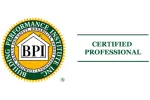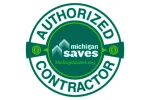Whether you're going to remodel your home or build a new one, proper attic insulation is a must. Codes vary by the State, as do many things. The attic insulation code for Michigan is based off of a number of variants. All of which we'll talk about below.
Attic Insulation Versus Heating and Cooling Units

In the winter when we heat our house, that hot air rises. Without insulation having cold contact points, the performance of your heating system will be greatly reduced. This is because your furnace will run more often, longer and harder. In the long run it's going to cost you a lot more money. Also, through all the air gaps in the attic you're going to lose the heated air that you're paying for. For every unit of air you lose inside, you pay to bring a new unit of air from outside.
Another example is in the summer. Your attic can get up to 140-150 degrees. Maybe you set your thermostat to 65 degrees. Cooling your house means you're trying to push condensed cooled air into the rooms of your home. With little or no insulation, there will be hot spots. Hot air likes the cold air, so all those hot spots are taking away the cold air you're pushing in. This is going to cause your a/c unit to run twice as much as it should or even more.
One thing's for sure, the cost to properly air seal and insulate your attic is certainly worth it. There is no doubt that it will drop the cost of your energy bills. Hence lessening the usage of your a/c unit and furnace. The attic insulation and air seal will pay for itself many times over.
Attic Insulation R-Value
The best attic insulation always depends on the way it's applied. You first have to ask yourself, what do I want to do with my attic space? There's Fiberglass and cellulose which are close in R-value. Cellulose does create a little better of an air barrier on its own. However, without an air seal you're not going to feel much of a difference between the two. With an air seal you will feel a big change with both fiberglass insulation and cellulose insulation.
For attic insulation our code book cites health, safety, and sanitation standards. However, the codes only list the minimum guidelines. This isn't really the best thing. For an attic the you could have an r-38 to meet the insulation code guidelines. However, if an r-38 was enough, customers wouldn't ask why they're still too cold or hot in their home. DTE Energy and Consumers Energy suggest an r-49 or above to be energy efficient. Energy Star states that an r-60 is equal to the best performing attic insulation.
As a result of being a DTE or Consumers customer you qualify for standard rebates. As long as you bring your r-value up to r-49, you can go online and apply.
Insulation Removal
If you have animals nesting in certain areas of your attic then insulation removal would be important. Also, full mold remediation would mean having to remove insulation. This is when you see many large spores growing all over the inside of your attic. A little mold on your roof deck from a bath fan that wasn't well vented, is okay. The present insulation would not need to be removed.
When hot decking, you would remove all of the attic insulation because you are insulating with a new material. At times people with attic insulation may just need to be brought to a higher r-value. In this case, we would push the other insulation aside, to create a proper air seal. Afterwards we then put your insulation back down and add to it. Unless you choose to have insulation removal.
How much insulation you need certainly depends on your own needs and the exposure of your home. You now know it could be anywhere from an r-38 to an r-60 as far as r-value goes. For more information on r-value, please refer back to our website. You will also find a quick checklist to help you know when you need more insulation.








